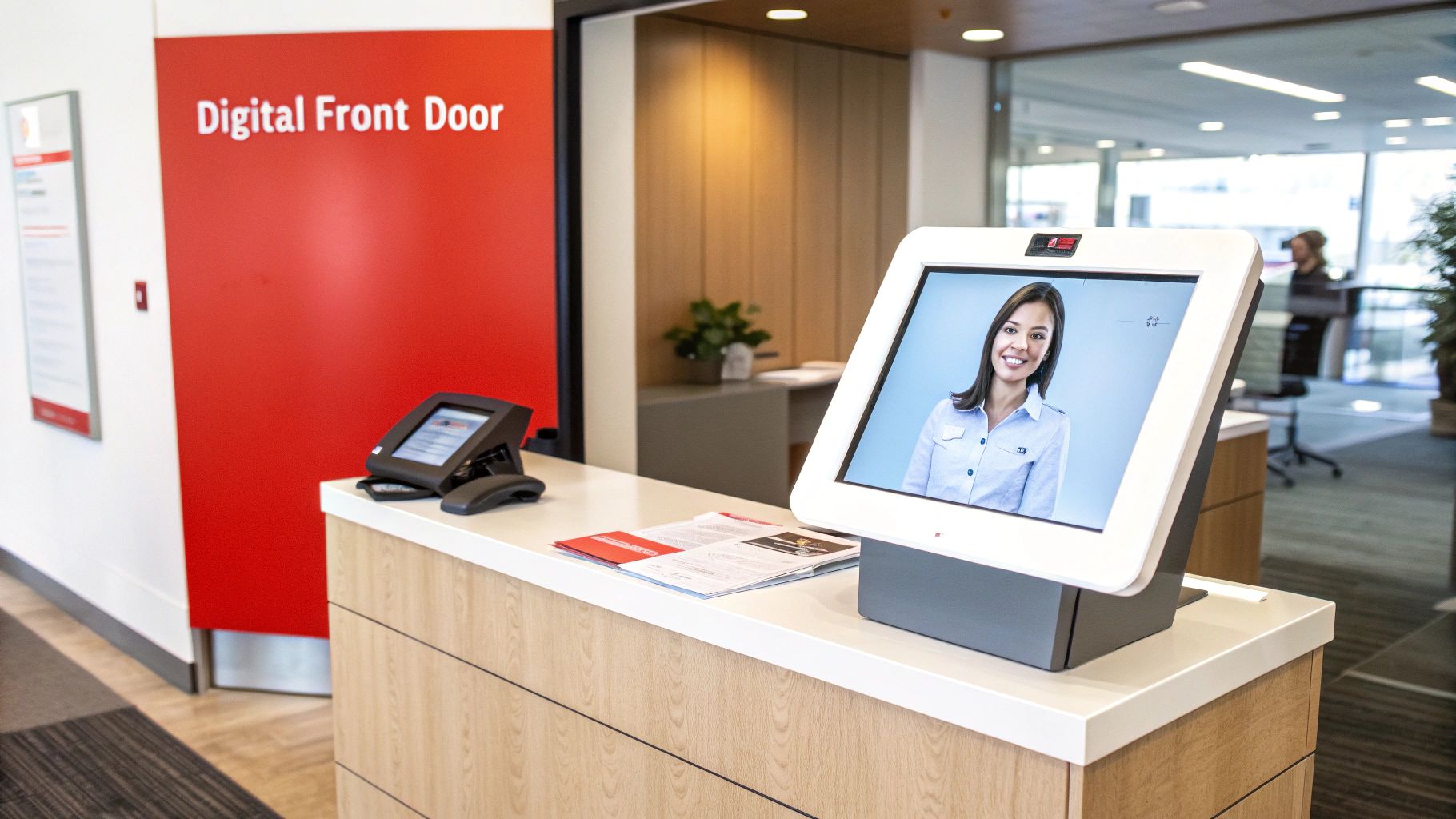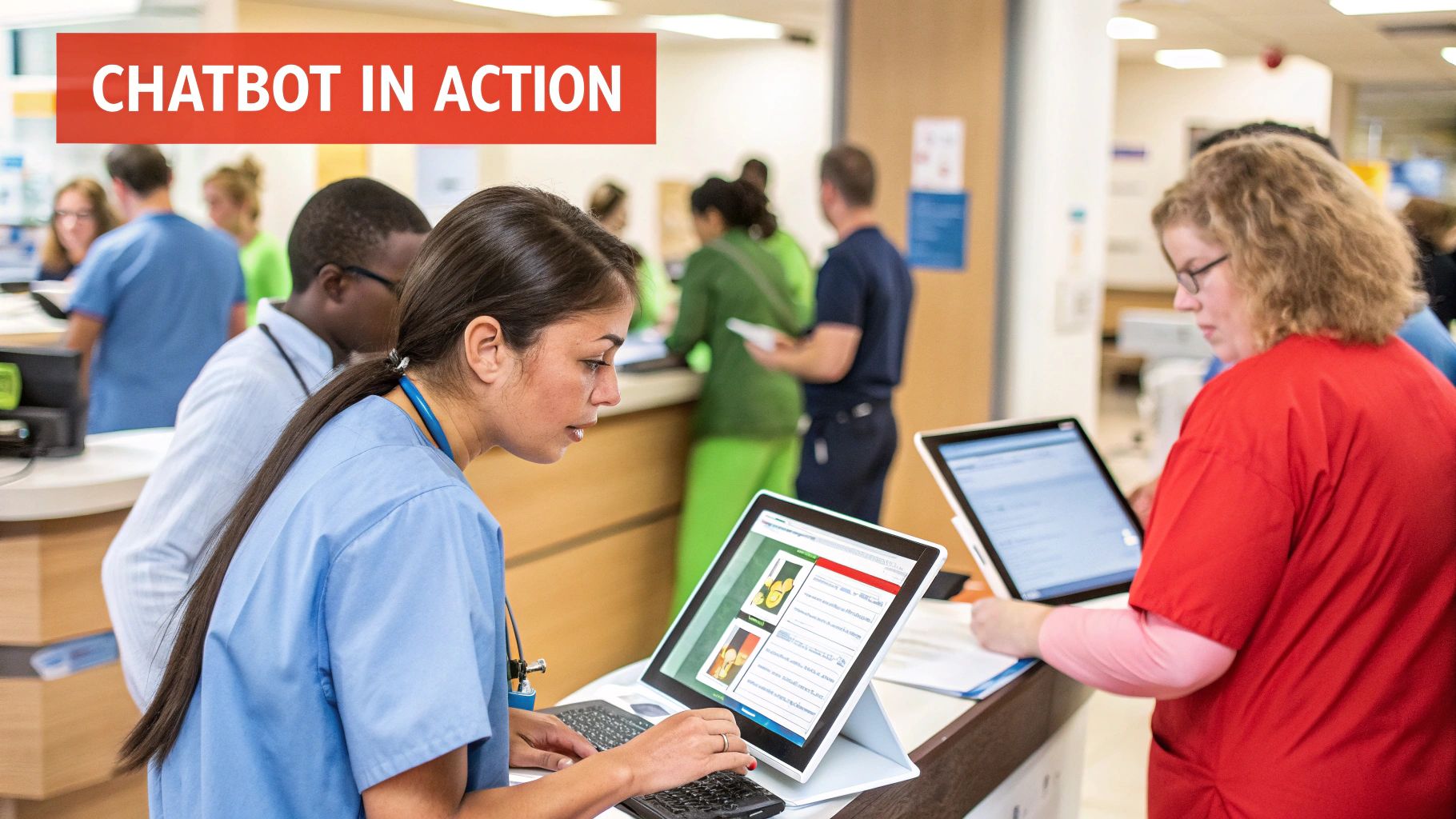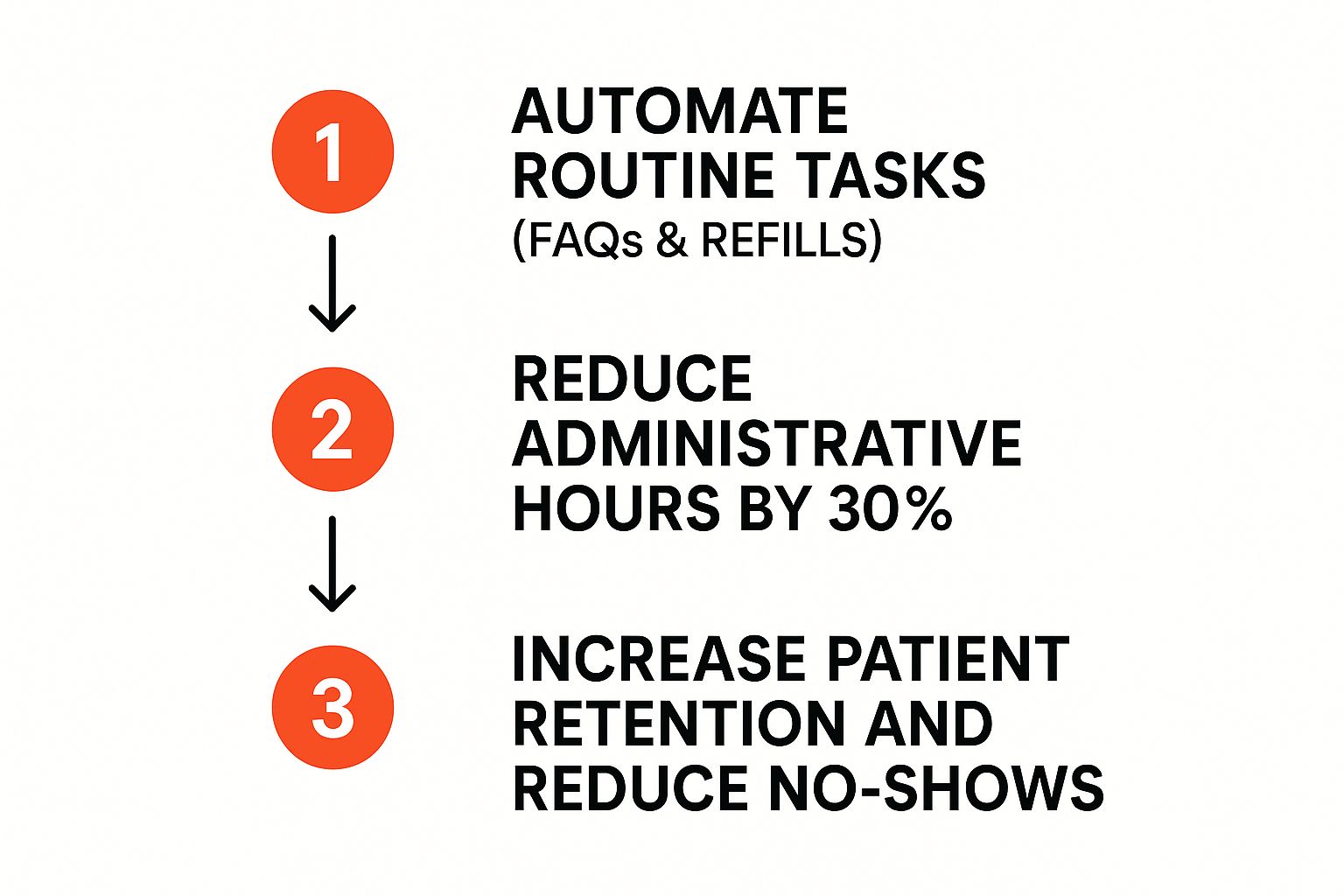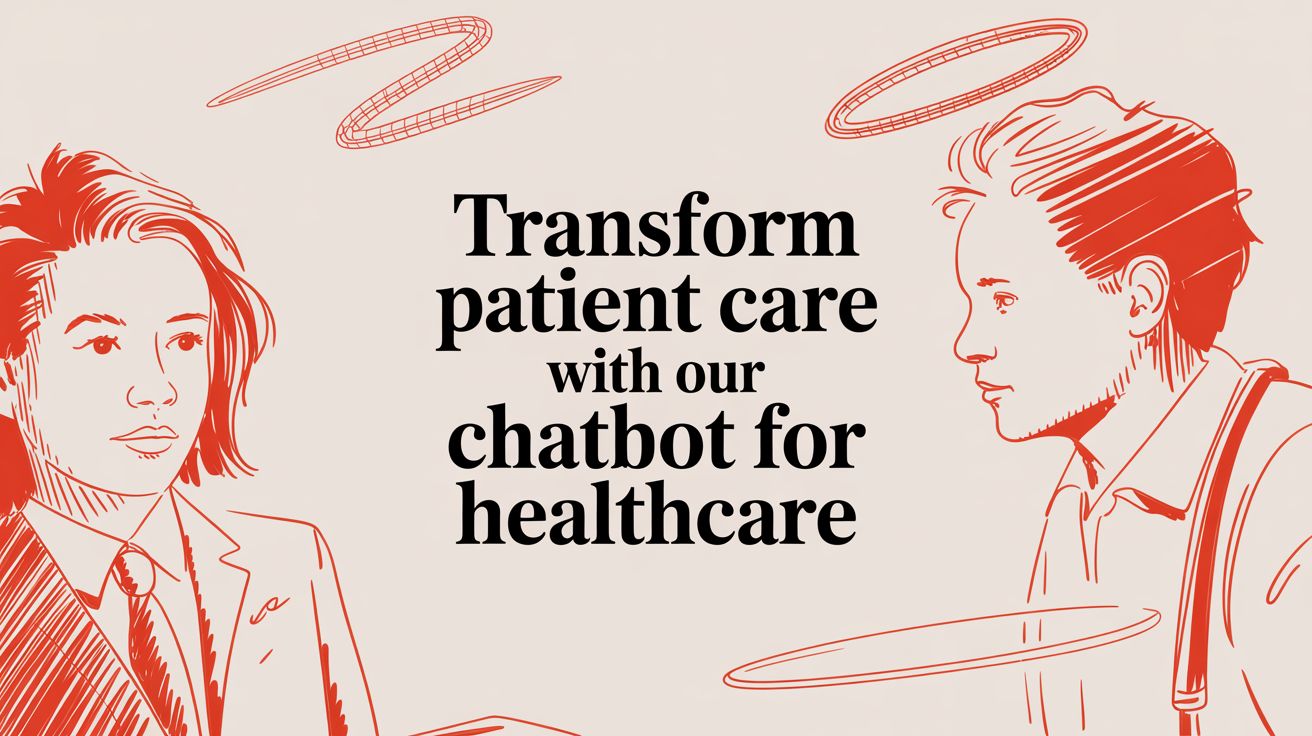Imagine your clinic had a front desk that never closed. A place where patients could get instant answers, book appointments, and find information anytime, day or night, without a single person ever getting tired. That’s essentially what a chatbot for healthcare brings to the table. It’s less about complicated code and more about a smart, tireless digital assistant built to make life easier for your patients and your team.
Your Digital Front Door for Patient Care

At its heart, a healthcare chatbot is a specialized program designed to mimic human conversation using text or voice. It acts as an automated first point of contact, smoothing out the communication lines between patients and providers. And we’re not just talking about canned, robotic responses anymore—today’s chatbots are far more intelligent.
The magic behind these tools is Natural Language Processing (NLP), a branch of artificial intelligence that gives them the uncanny ability to understand and respond to human language in a natural way. When a patient types, “I need to see Dr. Smith about a check-up next week,” the chatbot sees more than just words on a screen.
NLP allows it to break down the request to understand what the person actually wants:
- Intent: The patient is trying to book an appointment.
- Entities: The specific doctor is “Dr. Smith.”
- Context: The timing is “next week.”
This is what allows the chatbot to give a genuinely helpful response, like pulling up Dr. Smith’s available slots for the following week. It turns your static website into a dynamic, interactive resource, which is a core benefit we cover in our guide on adding a chatbot for website interactions.
The Perfect Digital Receptionist
You can really think of a chatbot for healthcare as the perfect digital receptionist. It works 24/7 without needing a coffee break, can juggle thousands of conversations at once, and always has the correct information handy. This around-the-clock availability is a massive win for patients, who can now get help or book care long after your office has closed for the day.
To give you a clearer picture, here’s a quick breakdown of what a healthcare chatbot can do for both sides of the patient-provider relationship.
Key Functions of a Healthcare Chatbot at a Glance
| Function Area | Patient Benefit | Provider Benefit |
|---|---|---|
| Appointment Management | Instantly book, reschedule, or cancel appointments 24/7. | Reduces no-shows with automated reminders and frees up front-desk staff. |
| Answering FAQs | Get immediate answers to common questions (e.g., hours, insurance). | Lowers call volume and repetitive inquiries, allowing staff to focus elsewhere. |
| Symptom Checking | Receive initial guidance on symptoms to determine the right next steps. | Helps triage patients and direct them to the appropriate level of care. |
| Medication Reminders | Get timely alerts to take medications as prescribed. | Improves patient adherence to treatment plans and overall health outcomes. |
| Patient Onboarding | Complete intake forms and pre-visit paperwork conveniently online. | Streamlines the check-in process and ensures data is collected accurately. |
This table just scratches the surface, but it highlights how these bots are more than just a novelty; they are practical tools that solve real problems.
By automating routine administrative tasks, a healthcare chatbot frees up your human staff to focus on more complex patient needs, enhancing both operational efficiency and the quality of care provided.
This isn’t just a niche trend. The global market for healthcare chatbots was valued at around USD 1.2 billion in 2024 and is expected to rocket to over USD 12.5 billion by 2035. This kind of growth speaks volumes about the real value practices are finding in these AI assistants.
By acting as a reliable, always-on digital front door, healthcare chatbots are fundamentally changing patient interactions for the better, making the entire experience smoother and more efficient for everyone.
How Chatbots Are Changing the Patient Experience

Beyond the technology, the real magic of a chatbot for healthcare is how it impacts people. These tools create a patient journey that feels more supportive and responsive by simply being there whenever help is needed. It’s a fundamental shift away from a system where patients have to wait for care, toward one that’s proactive and always connected.
The most obvious change is the end of the waiting game. Patients no longer have to navigate confusing phone menus or wait until the clinic opens. They get instant, reliable answers right away, which gives them a much-needed sense of control over their health.
Providing Peace of Mind Around the Clock
Think about a classic scenario. A parent is up in the middle of the night with a sick child who has a high fever. What are their options? A stressful trip to the emergency room that might not be necessary, or an anxious wait until morning to call the doctor’s office. This is exactly where a chatbot steps in.
A chatbot for healthcare offers immediate guidance based on medically sound information. It can ask about the child’s symptoms, age, and temperature, then provide clear, calm instructions based on established medical protocols. This isn’t just about sharing information; it’s about delivering peace of mind when people are at their most vulnerable.
A chatbot serves as an ever-present digital guide, calming patient anxieties with 24/7 accessibility and trusted information, which can help prevent avoidable emergency room visits and reduce strain on the healthcare system.
Having this kind of always-on support is a game-changer. It reassures patients that help is just a message away, turning moments of panic into opportunities for informed action. That builds incredible trust and solidifies the provider’s role as a true partner in their care.
Making Healthcare Proactive and Personal
The patient experience also gets a massive boost from proactive engagement. A good chatbot doesn’t just sit and wait for questions. It actively helps patients along their entire care journey, making them feel like someone is looking out for them. It’s a huge improvement over the hit-or-miss follow-up calls we’re all used to.
Just look at the difference:
- Before Chatbot: A patient leaves the clinic with a new prescription and a stack of pamphlets, hoping they remember everything the doctor said. It’s easy to miss a dose or forget to schedule that follow-up.
- After Chatbot: The patient gets automated, personalized medication reminders sent directly to their phone. A few days later, the chatbot checks in: “How are you feeling? Any questions about the new medication?” This creates a continuous loop of care.
This kind of personalized attention is incredibly effective at helping patients stick to their treatment plans. By automating these check-ins and reminders, healthcare providers can improve adherence and catch small issues before they snowball into bigger problems.
Empowering Patients with Information on Demand
Feeling empowered in your own healthcare journey often boils down to one thing: access to information. When patients can find what they need, when they need it, they become active partners in their own well-being. A chatbot becomes that central, easy-to-use hub for all their health questions and data.
This on-demand access completely changes the dynamic. It puts the patient back in the driver’s seat, allowing them to manage their health on their own schedule. At its core, a chatbot for healthcare turns the patient experience from a series of disconnected appointments into a continuous, supportive relationship.
Real-World Applications of Chatbots in Healthcare

The image above gives you a glimpse into a simple chatbot conversation, much like the early versions of this technology. While today’s tools are far more sophisticated, the core idea is the same: giving people immediate, automated answers.
So, let’s move past the theory. How does a modern chatbot for healthcare actually work in the real world? This isn’t science fiction; it’s a practical solution that clinics, hospitals, and specialized practices are using right now to solve real problems. These AI assistants are making a difference everywhere, from handling tedious admin work to providing patients with direct support.
The applications are incredibly varied and touch nearly every part of the patient experience. For example, a chatbot can act as a digital front door, asking a few quick questions to guide a patient to the right specialist or level of care. It can also be a personal medication coach, sending reminders and answering questions about prescriptions—a crucial tool for anyone managing a chronic illness.
Automating Clinic Operations and Scheduling
Picture a busy family practice. The front desk team is constantly on the phone, checking patients in, and swimming in paperwork. This is exactly where a chatbot for healthcare can step in and make a huge impact by taking over the repetitive tasks that eat up so much time.
Appointment management is one of the most common and effective uses. Instead of making patients wait on hold, a chatbot can handle scheduling instantly, 24/7. It syncs with the clinic’s calendar, shows open slots in real-time, and lets patients book, change, or cancel appointments right from the website. No more phone tag.
This automation also helps with pre-visit prep. The bot can send out new patient forms, gather insurance details, and answer FAQs about things like parking or clinic hours. Patients show up ready to go, which drastically cuts down on wait times and frees up your staff to focus on the people standing right in front of them.
Enhancing Post-Operative and Chronic Care Management
For a hospital, patient care doesn’t stop at discharge. The days and weeks after a procedure are critical for recovery, but this is often when patients feel most alone. A chatbot can fill that void and act as a virtual companion.
Think about someone recovering from knee surgery. A chatbot deployed by the hospital can:
- Send timed reminders to take medication or do physical therapy exercises.
- Answer common questions like, “Is it normal to have this much swelling?” or “What activities should I be avoiding?”
- Check in on progress by asking patients to rate their pain level or report any new symptoms.
- Flag potential problems and alert a human nurse to follow up if a patient’s answers suggest a complication.
This consistent, gentle contact helps patients feel supported and more in control of their own recovery. It also gives the clinical team a steady stream of data, allowing them to spot trouble early before it becomes a serious issue. The same logic applies to managing chronic conditions like diabetes, where chatbots can help with tracking blood sugar and offering lifestyle advice.
Providing Initial Mental Health Support
Mental wellness is another area where chatbots are truly making a difference. For many people, just taking that first step to ask for help is the hardest part. A chatbot for healthcare offers a private, non-judgmental space to start the conversation.
Many mental health platforms now use chatbots for initial screenings. They gently guide users through a series of questions to get a sense of their mood and identify potential concerns. From there, the chatbot can offer immediate help.
Patient: “I’ve been feeling really anxious lately and can’t sleep.”
Chatbot: “I’m sorry to hear that. Feeling anxious can be very difficult. Would you like to try a guided breathing exercise right now to help calm your mind? I can also share some articles on managing anxiety or help you find a therapist to speak with.”
This kind of interaction delivers instant, practical support. While it’s no substitute for a human therapist, it’s an incredible bridge to care, providing coping tools right when a person needs them most. To learn more about how immediate responses build trust, see our guide on setting up effective live chat support. This is key to creating a supportive digital environment, especially when handling sensitive health topics.
The Business Case for AI in Your Practice
Patient care is always the top priority, of course. But a thriving practice also has to run like a well-oiled business. That’s where a chatbot for healthcare comes in. Think of it less as a tech gadget and more as a smart financial move with a very clear return on investment (ROI). It’s designed to tackle the operational headaches that quietly drain your practice’s time and money every single day.
The business case boils down to one powerful concept: automation.
Every time a highly-skilled nurse or front-desk coordinator has to stop what they’re doing to answer a question about office hours, reset a patient portal password, or manually confirm an appointment, that’s a moment they aren’t helping a patient face-to-face. A chatbot takes over that entire administrative load, essentially acting as a force multiplier for your team.
This shift directly translates into real cost savings and a huge bump in efficiency. It frees up your human staff to focus on the complex, high-value work—like navigating tricky billing issues or providing clinical support—where their expertise truly shines.
Reducing Administrative Overhead
Just stop and think about the flood of calls and emails your practice fields on a daily basis. So many of them are the same repetitive questions: “Are you taking new patients?” or “What insurance do you accept?” A healthcare chatbot can instantly handle up to 80% of these common inquiries without needing a person to pick up the phone.
That massive drop in call volume creates a ripple effect across your operations:
- Lower Staffing Costs: You can manage a growing patient load without having to immediately hire more administrative staff.
- Increased Productivity: Your team can finally focus on their core tasks without constant interruptions.
- Reduced Human Error: Automating things like new patient data entry minimizes the kind of small mistakes that can snowball into major billing headaches or care delays.
This isn’t just about cutting costs. It’s about re-investing your most valuable asset—your team’s time—back into activities that actually generate revenue and improve patient outcomes.
By taking over routine administrative tasks, a chatbot for healthcare can slash operational costs by as much as 30%. This isn’t about replacing people; it’s about empowering them to work at the top of their game.
This is all part of a much bigger picture. The AI healthcare market is exploding, with global spending projected to jump from USD 22.4 billion in 2023 to a staggering USD 188 billion by 2030. Plus, AI is expected to trim overall healthcare costs by USD 13 billion by 2025. You can dig deeper into these AI healthcare statistics to see just how big this financial shift really is.
Boosting Revenue Through Better Patient Engagement
Beyond just saving money, a healthcare chatbot is a serious tool for bringing more revenue in the door. One of the biggest financial leaks in any practice is the no-show. Every missed appointment is lost income and a wasted time slot that another patient could have used.
A chatbot hits this problem head-on. It sends out smart, automated appointment reminders that let patients confirm or reschedule with a single tap. It’s a simple, interactive touch that’s way more effective than a phone call that goes to voicemail, and it dramatically cuts down on no-shows.
On top of that, better communication builds loyalty. When patients feel like they can get answers 24/7, they feel heard and supported. That makes them far more likely to stick with your practice for the long haul, which leads to more stable, predictable revenue.
A Tangible Return on Investment
Let’s make this real. Imagine a small clinic that decides to bring a chatbot on board.
| Metric | Before Chatbot | After Chatbot | Financial Impact |
|---|---|---|---|
| No-Show Rate | 15% | 8% | More filled appointment slots, leading to higher revenue. |
| Admin Time on FAQs | 10 hours/week | 2 hours/week | 8 staff hours freed up for direct patient care and billing. |
| New Patient Onboarding | 20 minutes/patient | 5 minutes/patient | Gets new patients in the system faster and improves staff efficiency. |
The business case is clear. A chatbot for healthcare isn’t an expense; it’s an investment in a smarter, more efficient practice. It cuts costs by automating the busywork, boosts revenue by keeping schedules full, and ultimately lets you build a practice that’s more profitable and more focused on patients.
A Practical Guide to Implementing Your Chatbot
Bringing any new technology into your practice takes a thoughtful plan, and a healthcare chatbot is no exception. This isn’t just about flipping a switch; it’s about carefully weaving a powerful new tool into your daily operations. The real goal is to create an experience that patients feel comfortable with and that your staff actually finds helpful.
A successful rollout starts by tackling the essentials first. Your entire strategy needs to be built on a rock-solid foundation of data security and patient privacy. Without that trust, even the most sophisticated chatbot will fall flat.
Laying the Foundation with Security and Compliance
In healthcare, patient data is more than just sensitive—it’s legally protected. Making sure you have robust security and full compliance with regulations like the Health Insurance Portability and Accountability Act (HIPAA) is your most critical first step. This means you have to choose a chatbot platform that was built from the ground up with healthcare’s strict privacy rules in mind.
Your chatbot will be handling Protected Health Information (PHI), so it absolutely must have end-to-end encryption for every conversation. You’ll also need strict access controls to ensure only authorized staff can see patient interaction data. It’s a good idea to have a clear data governance policy in place before the chatbot ever chats with its first patient.
Think of HIPAA compliance not as a roadblock, but as a way to build trust. When patients feel confident that their information is safe, they’re far more likely to use the tool, leading to better results for everyone.
Getting this right from the start protects your patients and your practice from serious legal and financial trouble. It’s the bedrock of a responsible and effective implementation.
Integrating with Your Existing Systems
A chatbot shouldn’t be an island. For it to be truly useful, it needs to connect smoothly with the systems you already rely on, especially your Electronic Health Record (EHR) system. This connection creates a single, unified flow of information that makes your administrative work easier and gives you better clinical insights.
When your chatbot and EHR are in sync, it can:
- Check real-time schedules to book appointments without conflicts.
- Verify a patient’s information instantly against their record.
- Log conversations and interactions directly into the patient’s file.
This integration ensures information is consistent everywhere, cutting down on the risk of typos and other manual entry errors. It gives your team a complete view of a patient’s journey, whether they called on the phone or used the chatbot. While the technical setup is a key step, you can find valuable insights on the foundational aspects in our guide covering how to build a chatbot from the ground up.
This infographic shows how automating routine tasks directly improves patient retention and your bottom line.

As you can see, cutting down on the administrative burden isn’t just about saving money—it’s a direct path to a happier, more engaged patient community.
Training Your Chatbot and Defining Human Handoffs
An out-of-the-box chatbot has no idea what makes your practice unique. It needs to be “trained” with accurate, vetted medical information and all the specifics about your services, hours, and policies. This training process is all about creating a comprehensive knowledge base the chatbot can pull from to give people reliable answers.
But let’s be realistic: no chatbot can or should handle everything. That’s why it’s so important to have a clear plan for when a conversation needs to be passed to a human. This “human-in-the-loop” approach is the key to keeping patients safe and satisfied.
You’ll want to set up clear triggers for when to escalate, such as:
- Complex Medical Questions that are beyond the chatbot’s programming.
- Any sign of urgency or distress from the patient.
- Multiple failed attempts by the chatbot to understand what someone is asking.
A smooth handoff, where the human agent gets the full chat history, saves patients from the frustration of repeating themselves and ensures nothing gets lost in translation. This hybrid model gives you the best of both worlds: the speed of automation and the irreplaceable empathy and expertise of your healthcare team.
To help guide you, we’ve put together a simple checklist to walk you through the key stages of getting your chatbot up and running.
Chatbot Implementation Checklist
| Phase | Key Action | Critical Consideration |
|---|---|---|
| 1. Planning & Strategy | Define clear goals (e.g., reduce call volume, improve appointment booking). | What specific problem are you trying to solve? |
| 2. Vendor Selection | Choose a HIPAA-compliant chatbot platform with EHR integration capabilities. | Does the vendor have proven experience in healthcare? |
| 3. Security & Compliance | Conduct a security review and sign a Business Associate Agreement (BAA). | Are all data storage and transmission methods encrypted? |
| 4. System Integration | Connect the chatbot to your EHR, scheduling software, and other key systems. | How will you ensure data remains consistent across all platforms? |
| 5. Content & Training | Build a knowledge base with vetted medical information and practice-specific details. | Who is responsible for keeping this information up-to-date? |
| 6. Handoff Protocol | Define clear triggers and workflows for escalating chats to human staff. | Is the transition seamless for both the patient and the staff member? |
| 7. Testing & Launch | Run a pilot with a small group of users to identify and fix bugs. | What does your feedback collection process look like? |
| 8. Optimization | Regularly review chat logs and user feedback to refine chatbot responses and workflows. | How will you measure success and track your initial goals? |
Following a structured plan like this takes the guesswork out of the process and sets you up for a much smoother, more successful launch.
The Future of AI Conversations in Patient Care
We’re really just scratching the surface of what a chatbot for healthcare can do. The journey is moving well beyond simple Q&A bots and into a future where AI provides proactive, deeply integrated support for patients. Soon, this technology will feel less like a tool you use and more like a genuine healthcare companion that anticipates your needs.
Think about a voice-enabled assistant offering hands-free health advice, letting an older patient ask about their medication schedule while their hands are busy in the kitchen. Or imagine a chatbot that doesn’t just remind a diabetic patient to check their blood sugar but actually analyzes the trends over time and offers helpful dietary suggestions.
This all points toward a healthcare ecosystem that’s far more connected and predictive than what we have today.
Toward a More Empathetic AI
The next major leap forward will be building genuine emotional intelligence into these systems. The chatbots of tomorrow will be able to pick up on subtle cues in a patient’s messages, like hints of frustration, confusion, or anxiety.
This sensitivity will allow the AI to respond with real empathy, maybe by offering a calming resource or, when needed, seamlessly handing the conversation over to a human caregiver for that compassionate touch.
The ultimate goal is not to replace the human element in medicine but to amplify it. Future AI will manage the data and logistics, freeing up clinicians to focus on what matters most: the patient relationship and complex medical decisions.
Creating a Connected Health Network
This vision gets even more exciting when you think about how these chatbots will connect with other technologies. Imagine a chatbot for healthcare that syncs with a smartwatch or other wearable devices to monitor vital signs in real-time. If it spots an unusual reading, it could proactively check in with the patient and alert their doctor if something seems wrong.
When you pair that capability with telehealth platforms, these AI assistants create a constant feedback loop of care that follows the patient long after they’ve left the clinic. It’s a forward-thinking approach that promises a healthcare system that is more personal, more predictive, and more accessible for everyone—one where technology strengthens the vital human connection at the heart of medicine.
Your Healthcare Chatbot Questions, Answered
Jumping into any new technology always brings up a few questions. I get it. When it comes to something as important as a chatbot for healthcare, decision-makers and clinic owners tend to have the same core concerns: cost, security, and what it means for their team. Let’s tackle these head-on.
Can a Small Clinic Actually Afford a Chatbot?
The thought of bringing “AI” into a small practice immediately makes most people think of a massive, budget-busting price tag. But that’s not the reality anymore. Modern chatbot platforms are built with smaller clinics in mind, offering flexible, subscription-based pricing. This means you can skip the huge upfront cost of custom development.
Instead of a daunting capital expense, you’re looking at a predictable monthly fee. It’s an operational cost, much like the other software you rely on every day. This approach puts powerful automation tools within reach for even solo practitioners, delivering a clear return by freeing up countless hours for your staff.
It’s a common myth that AI is reserved for huge hospital networks. The truth is, today’s chatbot tools are designed to be cost-effective and scalable, making them a genuinely practical investment for clinics of any size looking to work smarter and improve the patient experience.
Plus, these solutions are built for ease of use. You won’t need an IT department to get things rolling. Most can be added to your website with a simple copy-and-paste code snippet, getting you up and running in minutes, not months.
Are Healthcare Chatbots Secure and HIPAA Compliant?
This is the big one, and it’s non-negotiable. The answer is a resounding yes, but with a crucial condition: you have to choose the right partner. Any reputable chatbot for healthcare provider knows that protecting patient data is their absolute top priority. Their platforms are built from the ground up to meet the stringent demands of the Health Insurance Portability and Accountability Act (HIPAA).
This isn’t just a single feature; it’s a multi-layered commitment to security.
- End-to-End Encryption: This ensures that every conversation between a patient and the chatbot is completely scrambled and unreadable to anyone who shouldn’t see it.
- Secure Data Storage: Any patient information collected is stored in highly secure, access-controlled servers that are fully compliant with healthcare privacy laws.
- Business Associate Agreements (BAA): A trustworthy vendor will always sign a BAA. This is a legally binding contract that holds them accountable for safeguarding your patients’ protected health information (PHI).
When you’re evaluating a chatbot provider, your first questions should be about HIPAA compliance and their willingness to sign a BAA. This is the gold standard. It protects your patients, and it protects your practice from serious legal risk. Security isn’t an add-on; it’s the foundation of any chatbot worth considering in healthcare.
Will a Chatbot Replace Our Staff?
I hear this concern more than any other, and it’s an important one to address. The answer is a firm no. A chatbot for healthcare isn’t here to replace your talented team; it’s here to augment them. Think of it as the most reliable, tireless assistant you’ve ever had—one that handles the repetitive, administrative tasks that drain your team’s energy and time.
Imagine what a chatbot can take off your team’s plate right now:
- Answering the same ten questions about insurance or office hours, over and over again.
- Handling the back-and-forth of scheduling and rescheduling appointments.
- Collecting basic patient intake details before they even walk in the door.
By automating these tasks, the chatbot frees up your front desk staff, nurses, and medical assistants to focus on what humans do best: providing compassionate, hands-on care to the patients who need their full attention. It empowers your people to work at the top of their license, dealing with complex patient needs and building real relationships.
Essentially, the chatbot handles the noise so your team can focus on the care.
Ready to see how an AI assistant can turn your website into a patient-acquisition powerhouse? LeadBlaze offers a 24/7 chatbot that engages every visitor, qualifies them, and books appointments on autopilot. Start your 7-day free trial and discover a smarter way to grow your practice.
